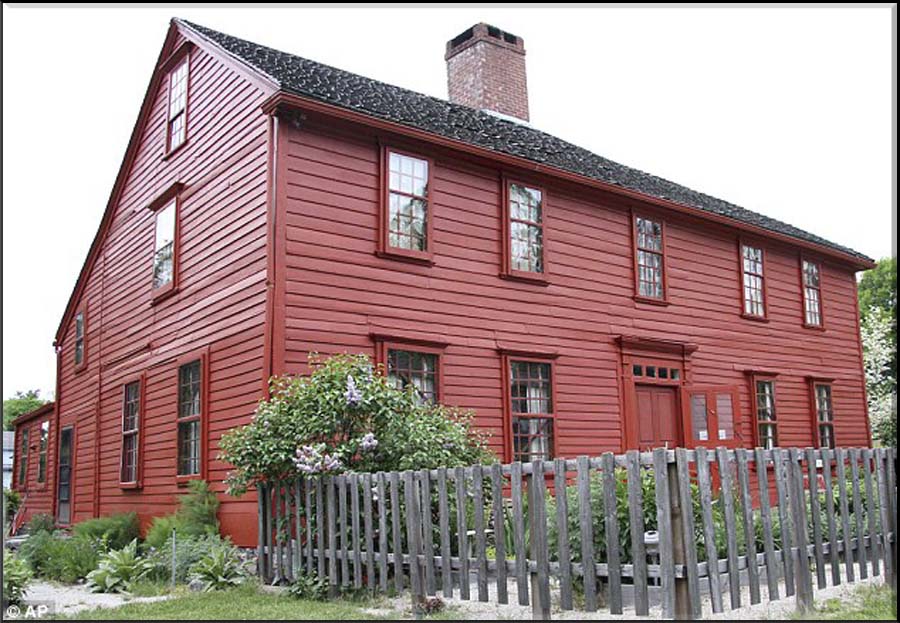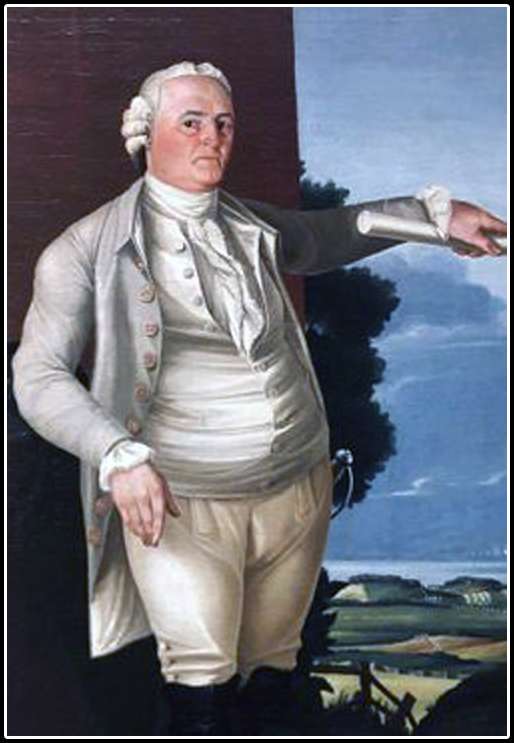Ensign Thomas Leffingwell (1649-1724)
Ensign Thomas Leffingwell was born to Lt. Thomas Leffingwell and Mary White on August 27, 1649 in Saybrook Connecticut. Thomas moved with his family in 1660 to the new settlement of Norwich where he spent the rest of his life. He was a very enterprising business man and one of the most successful in town.
Colonists during this time period were considered “commoners”, with no particular rights or vested interests in community affairs. Once they had proven themselves to be men of quality and trustworthiness, they could be advanced to the status of a “Freeman”. In 1671 Thomas was made a Freeman by the General Court in Hartford.
In May of 1701 Thomas Leffingwell was appointed as Ensign of the militia at Norwich. Thereafter, he was known as Ensign Thomas Leffingwell, while his father retained the title of Lieutenant Thomas Leffingwell.

On May 13, 1703, while serving as a Norwich representative in the General Court, he voted to create a township called by the name of Windham. His father, Lt. Thomas Leffingwell and several other men were designated as proprietors of Windham.
Ensign Thomas Leffingwell settled and always lived near his father. In 1700 Stephen Backus sold the house and property, that is known today as the Leffingwell House Museum to Ensign Thomas Leffingwell. In 1701 Thomas was granted permission “to keep a publicque house of entertainment for strangers”. His house became the ordinary of the town. At that point-in-time only the most respected citizens were permitted to “enterteiyn” strangers. The building is now listed on the National Register of Historic Places.
The inventory of his property made in 1724 shows that he was richly furnished; not only with the household comforts and conveniences of that era, but even with articles of luxury and elegance. He had furniture and linen in abundance, wooden ware, and utensils of all kinds. The inn was also one of the places where ammunition was stored for emergency.
Some believe that the Leffingwell House is haunted by ghosts today.
Acknowledgements
National Park Service
FindAGrave.com
Daily Mail
Boston Trowtrow (circa 1706-1772)
The following is an excerpt from the Info Source :
“The gravesite of Boston Trowtrow recalls a long-forgotten practice in Colonial New England of electing “black governors,” or “kings,” to represent local slave populations. Trowtrow served as Norwich’s black governor from 1770 to 1772 and was one of three known leaders from Norwich.
In Connecticut, elections for black governors began in the 1750s, when slaves accompanying their owners to Hartford for the colony’s annual gubernatorial election chose their own leader as well. Later, Connecticut’s slaves voted for these “governors” locally and sent the results to Hartford on the Saturday after the general election, when the winner was formally declared. The occasion was celebrated with a dinner, followed by an “inaugural” parade with the newly named black governor marching at its head.”
“Despite the local status of these black leaders, their authority was primarily limited to upholding order within the African-American community. It is thought that their white owners — usually among the town’s most prominent citizens — promoted the practice as a means to prevent uprisings. Trowtrow is believed to have been the slave of Jabez Huntington (1719–1786), one of Norwich’s most successful Colonial-era merchants.”
Boston Trowtrow is buried in the Old Norwichtown Cemetery.
Acknowledgements
“Boston Trowtrow Served as Norwich’s ‘Black Governor”, by Regan Miner, (02/09/2020)
FindAGrave.com
Hannah Waterman Arnold (1708-1759)
*Place cursor over image to magnify
Hannah Arnold was born in Norwich John and Elizabeth Waterman. Her first husband, Absalom King, was a wealthy merchant who had settled in the area. The couple had a daughter, also named Hannah. Not long after, however, King died at sea from the smallpox Hannah married again, this time to Capt. Benedict Arnold, the descendant of Rhode Island, Governor Benedict Arnold. The Arnolds had six children, including the infamous, Benedict Arnold V.
This postcard illustrates the Hannah’s home and the birthplace of Benedict Arnold in Norwich Connecticut. The home was located on the corner of present-day Arnold Place and Washington Street.
Hannah Arnold is buried in the Old Norwichtown Cemetery. The plaque next to her grave reads :
“Once Upon a Time in Norwich … an 18 year old Benedict Arnold [V] stood on this spot and watched as they lowered his long-suffering mother into her grave. Benedict himself was an apprentice bound by indentured servitude to his mother’s cousins, the Lathrop Brothers. His father was suffering from alcohol-induced dementia, believed caused by his sadness over losing four children: Absalom, Elizabeth, Mary, and an earlier son named Benedict [IV], who died an infant in 1739. The children are all buried here.”
“Hannah Arnold died on August 15, 1759; her husband some years later. Young Benedict [V] moved to New Haven with his sister Hannah, and became extremely successful. He married Margaret Mansfield who died June 19, 1775. In New Haven, Arnold founded and commanded the 2nd Connecticut Foot Guard. During the American revolution, he was a hero and became George Washington’s finest field general, winning many victories …..”
The complete text on the plaque can be viewed on Info Source 1.
The left photo of her gravestone was taken in 2023 and the right one one was taken in 2006.
Click HERE for more details of the life and times of Benedict Arnold.
View of gravestone in 1995
*Place cursor on image to magnify
Her headstone reads:
IN MEMORY of
Hannah ye well beloved
Wife of Capt. Benedict
Arnold & Daughter of
Mr. John & Elizabeth
Waterman, (She was a
Pattern of Piety Patience
and Virtue) who died
August 15, 1759
AEtatis Suae 52
It is interesting to compare the condition of the gravestone in the 1995, 2006, and 2023 photos. It is clear that the stone was cleaned and refurbished between the years of 1995 and 2006.
Upon close inspection of the winged cherub, it is also evident that the stone was cleaned again between 2006 and 2023.
The report states:
“This stone is in remembrance of Hannah Arnold. Not only was she the mother of the traitor Benedict Arnold, but she was the daughter of a prominent Norwich citizen. This stone appeared to be the only one of its kind in this burial ground. James Slater thinks it was probably carved by John Stevens II. The stone was probably carved by of Newport, RI … This is a strong possibility because Benedict Arnold’s grandfather (Benedict Arnold III) was the Governor of Rhode Island.” (Info Source 2)
*Click on the arrow to expand report
Acknowledgements
“1708-1759 Hannah Lathrop Waterman Arnold”, FindAGrave.com
“Hannah Arnold Gravestone Report,” (1995), by Ellen B. Wilson
FindAGrave.com
The complete list of sources may be found by clicking the “Bibliography” button, and, then entering “Hannah Arnold” in the SEARCH box.

General Jabez Huntington (1719-1786)
Jabez Huntington was a successful international merchant, a valiant statesman who represented Norwich, and a trusted confidant of George Washington.
He graduated from Yale College in 1741 and after the death of his father in 1745 he assumed control of the family business. Jabez largely added to the ample fortune left him by his father and at the beginning of the Revolution owned a large number of sea-going vessels engaged in trade with the West Indies.
Jabez Huntington represented Norwich in the Connecticut General Assembly. For several years he was either a member of the Lower House, over which he often presided, or was one of the Assistants.
In early 1765 the Connecticut Colonial Governor, Thomas Fitch, presented the terms of the proposed British Stamp Act to his council. When he suggested that the council members should take an oath which would require the implementation of that obnoxious measure, Jabez Huntington, and a majority of the council, refused and indignantly left the chamber.
Though he could not foresee that a war would greatly endanger his shipping business, and perhaps lead to the utter ruin of his fortunes, not for a moment would Huntington allow his interests to interfere with his patriotism. He was one of the most active members of the Committee of Safety. In 1776 he and General Wooster were appointed as the two Major Generals of the Connecticut militia. Upon General Wooster’s death in 1777, Huntington was placed in charge of the entire Connecticut militia.
During the Revolutionary War General Huntington was he was in constant correspondence with George Washington, Marquis de Lafayette, John Hancock, Roger Sherman, and Jonathan Trumbull. He gave generously to the cause and when ammunition was scarce, it is said that he at one time “permitted even the leaden weights, by which his windows hung, to be cast into bullets”.

According to Info Source 2 : During the time of the Revolutionary War General Jabez Huntington was one of six people in Norwich who owned a chaise (a.k.a. gig or carriage). His chaise was a large, low, square-bodied and studded with brass nails that had square and flat heads. His carriage was the first in town that had a top which could be thrown back.
His chaise likely looked similar to the drawing shown on the left.
Family Life
Jabez Huntington was the son of Captain Joshua and Hannah Perkins Huntington. His great-father, Deacon Simon Huntington (1629-1706) was one of the original 35 founders of Norwich. In 1742, he married Elizabeth Backus, also a descendant of two Norwich founders, Lt. William Backus Jr. and William Backus Sr. The Huntington family lived in the Bradford-Huntington House, one of Norwich’s National Register of Historic Places.
The next year, in 1743, they had their first son Jedediah Huntington. He later graduated from both Harvard and Yale, became one of the Sons of Liberty, and fought along side George Washington at Valley Forge. His other son, Colonel Joshua Huntington, also fought in several battles during the Revolutionary War.
Sadly, three years later, Elizabeth died a month after giving birth to her second son, Andrew. The next year, Jabez married Hannah Williams. They had five children.
Though a strong athletic man, the great strain of the trying times upon his health and strength, led to a failure of both mental and physical powers. He retired from active service in 1779, and the last seven years of his life were passed in great mental and bodily suffering until his death in 1786.
He is buried in the Old Norwichtown Cemetery, along with both of his wives Elizabeth and Hannah.
Acknowledgements
“Old Houses of the Ancient Town of Norwich, 1600-1800”, (1895), pp 282-287, by Mary Elizabeth Perkins
“History of Norwich, Connecticut: From Its Possession From the Indians, to the Year 1866”, page 416, by Frances Manwaring Caulkins
FindAGrave.com
The complete list of sources may be found by clicking the “Bibliography” button, and, then entering “linseed oil” in the SEARCH box.
Major John Durkee (1728-1782)

John Durkee, the second child of Deacon William Durkee and Susannah Durkee, was born at Windham on December 11, 1728. Around 1750 he removed to Norwich where he married Martha Wood on January 3, 1753. He kept a tavern on Bean Hill, cultivated a farm, was a courageous military leader and was often engaged in public business.
In 1756, almost 20 years before the Revolutionary War, John Durkee’s military career began with his enlistment in the British Army based in the Connecticut Colony. He was first commissioned by the Connecticut General Assembly as a second lieutenant of the Fourth Company in the Second Regiment. Two years later he became the Company Commander of the Third Regiment and was given the title of Major.
Major Durkee and his Norwich based unit served in the forces engaged in the French and Indian War against the French in Canada during seven campaigns. He served for seven successive years, his term of service in each year being about nine months’ duration. At the completion of the war France ceded Canada to Britain in 1763.
Two years later on March 22, 1765 Britain passed the Stamp Act. This legislation was designed to force American colonists to pay a portion of British debt incurred during the French and Indian War. The colonists immediately protested and secret organizations, called the “Sons of Liberty” sprang up throughout the colonies. Info Source 1 states that the headquarters for the Sons of Liberty in Connecticut was in Norwich, and that Major Durkee was a very active and influential member of the organization.
Jared Ingersol of New Haven was appointed by the Connecticut General Assembly to be the tax collector in Connecticut. In August 1765 Jared Ingersoll was hung and burned in effigy in Windham and a month later the citizens of New Haven requested that he resign. However, he refused. In protest of the pending implementation of the Stamp Act, Liberty Poles and Liberty Trees suddenly appeared throughout the colonies. Norwich erected a Liberty Pole in the fall of 1765.
Shortly thereafter, Major John Durkee led a group of more than 1000 protesters, mostly from Norwich and New London, to confront Ingersoll. The group, later called “Durkee’s Irregulars”, caught up with Ingersoll in an area south of Wethersfield. After several hours of “negotiation” with Major Durkee, Ingersoll resigned saying “This cause is not worth dying for.” At which point Durkee compelled Ingersoll to shout “Liberty and Property” three times before the crowd. Three Huzza!’s were given and the whole company immediately dispersed without the least disturbance.
From that day forward, Major John Durkee had the nickname the “Bold Bean Hiller”.
When the Stamp Act went into effect a few weeks later on November 1, 1765, there were neither stamps or a stamp master in Connecticut. Major John Durkee played an important role in protecting the rights of colonists throughout all Connecticut. On the day after the Stamp Act was repealed, nowhere was there a celebration with more enthusiasm than at the Pavilion under the Liberty Tree on Norwichtown Green on March 19, 1767.
The Wyoming Valley was first inhabited by the Shawanese and Delaware Indian tribes in the early 18th century. By 1769 a group of people mainly from Norwich and Windham, led by John Durkee, became the first Europeans to reach the area. The settlement was named Wilkes-Barré after John Wilkes and Isaac Barré, two British members of Parliament who supported colonial America.
The first fort built by the Connecticut settlers, shown on the left, was named for for their leader, Major John Durkee.
The initial settlers were aligned with Connecticut, which had a claim on the land that rivaled Pennsylvania’s. However, armed men loyal to Pennsylvania twice attempted to evict the residents of Wilkes-Barré in what came to be known as the Pennamite Wars. After the Revolutionary War, the conflict was resolved so that the Connecticut settlers retained title to their lands but were forced to transfer their allegiance to Pennsylvania.
Major Durkee and his wife Martha are buried in the Old Norwichtown Cemetery.
Acknowledgements
“A History of Wilkes-Barré, Luzerne County Pennsylvania“, Volume 1, page 482, by Oscar Jewell Harvey, (1909)
“300 Years of Wyoming Valley History”, by Mary Theresa Biebel
The complete list of sources may be found by clicking the “Bibliography” button, and, then typing “Major John Durkee” in the SEARCH box.